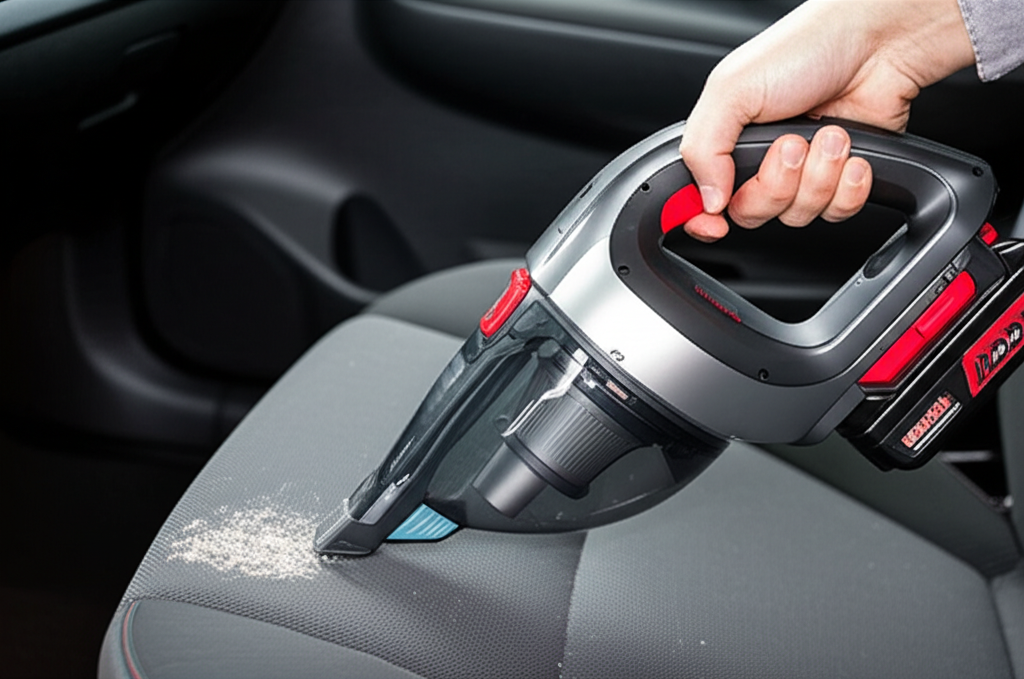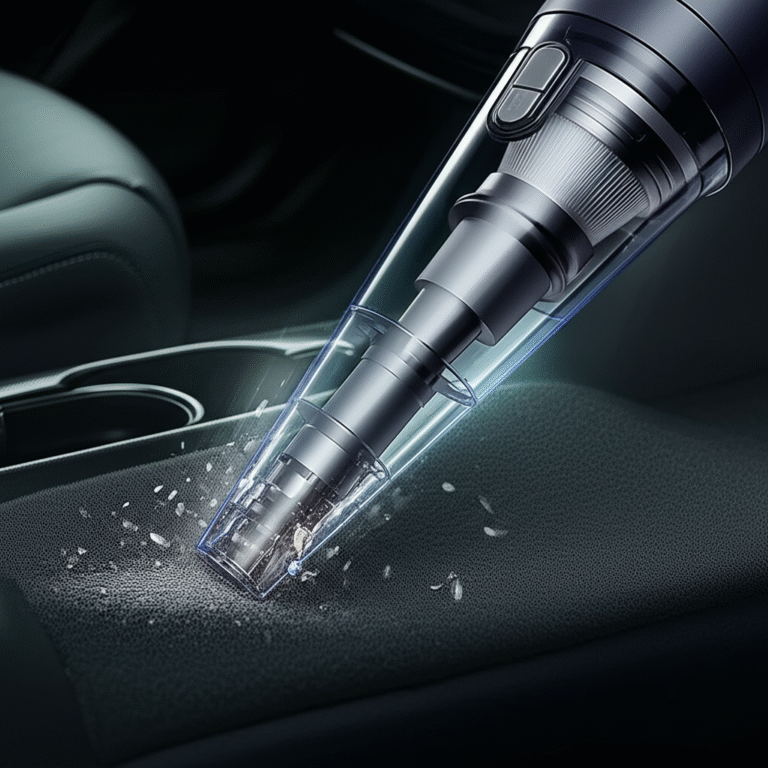The best vacuum cleaner for cars is a powerful, portable, and versatile cordless model with strong suction, specialized attachments, and a long-lasting battery, making quick work of dirt, debris, and pet hair in tight spaces.
Let’s face it, keeping your car’s interior spotless can feel like a losing battle. Crumbs find their way into every crevice, dust bunnies gather under the seats, and that stubborn pet hair seems to cling to upholstery like glue. You’ve probably tried a regular household vacuum, only to wrestle with a bulky hose and cord that never quite reaches everywhere. It’s frustrating, right? But don’t worry, I’ve been there, and I’m here to guide you. This guide will break down exactly what makes a car vacuum a winner, helping you choose the perfect tool to make your ride sparkle, no matter your experience level.
Why a Dedicated Car Vacuum is a Game Changer
Think of it this way: you wouldn’t use a sledgehammer to hang a picture frame, and you shouldn’t use a full-sized vacuum for your car’s interior. Dedicated car vacuums are designed with your vehicle’s specific needs in mind. They’re typically:
- Compact and Lightweight: Easy to maneuver in tight spaces like footwells, under seats, and in door pockets.
- Cordless: Freedom from outlets means you can clean anywhere, anytime.
- Powerful Suction: Engineered to pick up fine dust, sand, and even larger debris effectively.
- Specialized Attachments: Crevice tools, brush heads, and extension wands are crucial for reaching every nook and cranny.
Using the right tool makes the job faster, easier, and much more effective. You’ll be amazed at how much cleaner your car can get when you have a vacuum built for the task.
Key Features to Look For in a Car Vacuum
When you’re shopping, keep these essential features in mind. They’re the difference between a tool that works and a tool that works for you.
1. Suction Power (Air Watts or Pascals)

This is the heart of any vacuum. For car interiors, you need enough power to lift embedded dirt and pet hair from fabric and carpets. Look for specifications like:
- Air Watts (AW): A more accurate measure of overall suction power, considering airflow. Higher AW generally means better cleaning.
- Pascals (Pa): Measures the pressure difference created by the vacuum. Again, higher is usually better.
While manufacturers often list these, real-world performance is key. Reading reviews from other car owners can give you a good idea of how well a vacuum handles typical car messes.
2. Battery Life and Type
Cordless is king for car cleaning, but not all batteries are created equal.
- Lithium-Ion (Li-ion): The modern standard. They offer longer runtimes, charge faster, and don’t have a “memory effect” (where you lose capacity if you recharge before it’s fully drained).
- Runtime: Aim for at least 15-20 minutes of continuous use on a single charge. Many car vacuums offer different power modes, so check the runtime for each.
- Charge Time: How long does it take to fully recharge? If you plan on frequent cleanings, a quicker charge time is a definite plus.
Consider if the battery is integrated or removable. Removable batteries allow you to buy spares for extended cleaning sessions, which can be handy for larger vehicles or deep cleans.
3. Attachments and Accessories
This is where car vacuums truly shine. The right attachments make all the difference:
- Crevice Tool: Essential for cleaning between seats, along door panels, and in tight corners.
- Upholstery Brush Tool: Soft bristles help lift dirt and hair from fabric seats and carpets without causing damage.
- Dusting Brush: Great for dashboards, vents, and other delicate surfaces.
- Extension Wand/Hose: Allows you to reach under seats or into the trunk without contorting yourself.
- Pet Hair Tool: Some vacuums come with specialized rubberized or motorized brush heads designed specifically to tackle stubborn pet hair.
Check what’s included in the box. You might be able to purchase additional attachments separately if needed.
4. Dustbin Capacity and Ease of Emptying
Car vacuums typically have smaller dustbins than household models. A capacity of around 0.5 liters is common. The crucial part is how easy it is to empty. Look for:
- Bagless Design: Most modern vacuums are bagless, which saves money and hassle.
- One-Touch Emptying: A simple button or lever to release the contents directly into a trash can.
- Washable Filter: Many vacuums have washable filters, which is cost-effective and helps maintain suction power. Check the manufacturer’s recommendations for cleaning.
Nobody wants to struggle to empty a dustbin full of car grime. A quick, clean process is a must.
5. Filtration System
A good filtration system traps fine dust and allergens, preventing them from being recirculated into the air. HEPA filters are the gold standard for capturing microscopic particles. While not always standard on smaller car vacuums, a multi-stage filtration system is a good indicator of a quality product.
For those with allergies or respiratory sensitivities, a HEPA-filtered vacuum is highly recommended. You can learn more about HEPA filtration standards from organizations like the U.S. Environmental Protection Agency (EPA).
Top Types of Car Vacuums
When you’re looking for a car vacuum, you’ll encounter a few main categories. Each has its own strengths:
| Type | Pros | Cons |
|---|---|---|
| Handheld Cordless Vacuums | Most common for cars. Lightweight, portable, easy to store. Excellent for quick cleanups and tight spaces. | Smaller dustbins, potentially shorter runtimes compared to larger models. May struggle with very deep, heavy messes. |
| Corded Handheld Vacuums | Consistent power, no battery worries. Often more affordable. | Tethered by a cord, limiting reach and requiring access to a power outlet. Can be cumbersome. |
| Wet/Dry Vacuums (Shop Vacs) | Very powerful, can handle liquids and large debris. Durable. | Much larger, heavier, and less portable. Often require a power outlet. Overkill for most routine car cleaning. |
| Stick Vacuums (with Handheld Mode) | Versatile; can be used for floors and then converted to a handheld for cars. Good suction. | Can be bulkier to store than dedicated handhelds. Some models might be less agile in very confined car spaces. |
For most car owners, a dedicated handheld cordless vacuum is the sweet spot. They offer the best balance of power, portability, and convenience.
How to Choose the Best Vacuum Cleaner to Clean Cars: A Step-by-Step Approach
Ready to find your perfect car cleaning companion? Follow these steps:
Step 1: Assess Your Needs
Before you even look at models, think about your car and your cleaning habits:
- Vehicle Type: Do you have a small sedan, a large SUV, a truck, or a boat? More space means you might need a longer runtime or a larger dustbin.
- Typical Messes: Are you dealing with daily crumbs, or do you have pets that shed constantly? Pet hair requires stronger suction and specialized attachments.
- Frequency of Cleaning: Do you do a quick wipe-down weekly, or a deep clean monthly?
- Storage Space: Where will you keep the vacuum? Compact models are easier to store in a garage, trunk, or even a closet.
Step 2: Prioritize Key Features
Based on your needs, rank the features we discussed earlier:
- Suction Power: Essential for effective cleaning.
- Battery Life: Crucial for cordless convenience.
- Attachments: Vital for reaching all areas.
- Portability/Weight: Makes the job easier.
- Dustbin Capacity & Ease of Emptying: For a clean and simple process.
- Filtration: Important for air quality.
Step 3: Set Your Budget
Car vacuums range from budget-friendly options under $50 to premium models costing $200 or more. Generally, you get what you pay for in terms of suction power, battery life, and durability. A good mid-range vacuum often provides the best value.
Step 4: Research and Compare Models
Now it’s time to hit the stores or browse online. Look at reputable brands known for power tools and vacuums. Read reviews, paying close attention to:
- User experiences with car cleaning specifically.
- Durability and build quality.
- Real-world battery performance.
- Effectiveness on different surfaces (fabric, leather, plastic).
Consider brands like Black+Decker, DeWalt, Craftsman, Dyson (though often pricier), and Armor All. Many tool brands offer car vacuums that use the same battery platform as their other cordless tools, which can be a huge advantage if you’re building a cordless tool collection.
Step 5: Check for Warranties and Return Policies
A good warranty (1-2 years is common) provides peace of mind. Make sure the retailer has a reasonable return policy in case the vacuum doesn’t meet your expectations.
Tips for Effective Car Vacuuming
Once you have your vacuum, here’s how to get the most out of it:
- Start from the Top: Work your way down from the dashboard and headliner to the seats and floor mats. This way, any dislodged dust falls to areas you haven’t cleaned yet.
- Use the Right Attachments: The crevice tool is your best friend for seams and tight spots. Use the brush attachment for fabric seats to agitate and lift dirt.
- Pre-Treat Stains: For stubborn spots or heavily soiled areas, consider using a fabric cleaner or upholstery spray first. Let it sit for a few minutes before vacuuming.
- Empty the Dustbin Regularly: A full dustbin reduces suction power. Empty it after each use or when it reaches the halfway mark.
- Clean Your Filters: Washable filters should be cleaned according to the manufacturer’s instructions. A clogged filter severely impacts performance.
- Don’t Forget the Trunk: The trunk often collects the most dirt and debris. Use your extension wand to reach the furthest corners.
- Consider a Car Detailing Brush Set: Beyond vacuum attachments, specialized brushes can help loosen dirt from vents and crevices, making them easier to vacuum up. You can find excellent car detailing brush sets that work wonders.
Frequently Asked Questions (FAQs)
What is the most important feature in a car vacuum?
The most important feature is strong suction power. Without it, the vacuum won’t effectively pick up dirt, sand, and especially pet hair from your car’s upholstery and carpets.
Are cordless car vacuums powerful enough?
Yes, many modern cordless car vacuums offer impressive suction power, comparable to some corded models. Look for units with high Air Watts (AW) or Pascals (Pa) for the best performance.
How long should a car vacuum battery last?
A good cordless car vacuum should provide at least 15-20 minutes of continuous runtime on a single charge. Some models offer different power modes, so check the runtime for each.
Do I need special attachments for my car vacuum?
Yes, specialized attachments like crevice tools, upholstery brushes, and dusting brushes are essential for effectively cleaning the various surfaces and tight spaces within a car.
Can I use a wet/dry car vacuum?
A wet/dry vacuum can be useful if you frequently deal with spills or need to clean up larger debris. However, they are typically larger and less portable than dedicated handheld car vacuums, making them less ideal for routine cleaning.
How often should I clean my car vacuum’s filter?
It’s best to check your vacuum’s manual, but most washable filters should be cleaned after every few uses or when you notice a decrease in suction. Ensure the filter is completely dry before reinserting it.
Conclusion
Keeping your car’s interior looking sharp doesn’t have to be a chore. By understanding what features matter most – strong suction, long battery life, and the right attachments – you can easily find a vacuum cleaner that makes car cleaning a breeze. Whether you’re a weekend warrior detailing your ride or just need to tackle everyday messes, the perfect car vacuum is out there. Invest in a good tool, use the right techniques, and you’ll be enjoying a cleaner, more comfortable car in no time. Happy cleaning!
